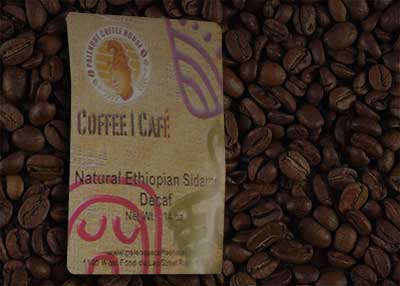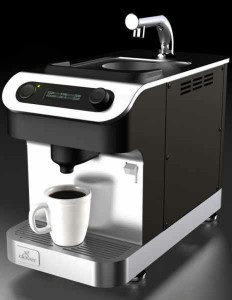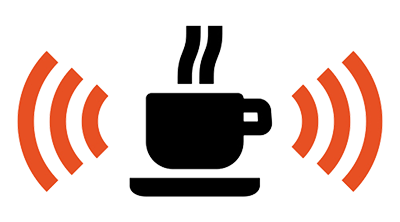Posted on May 14, 2012

Because you saw so many references to wet hulling in the descriptions of coffee growing regions in Indonesia in the previous section, it’s worth taking some time here in order to fully explore what the process means. The wet hulling process refers to the mechanical removal of the coffee’s outer “hull,” also known as the parchment and silverskin of the coffee berry. Because it is a “wet” coffee process, this means that the mechanical processing takes place after the coffee berries have already been washed in water in order to soften the outer layers and make them easier to remove. In the dry processing of coffee, all of these elements of the coffee berry are removed at the same time. Wet processing typically is inexpensive compared to dry processing because dry processing requires manual labor whereas wet processing can largely be handled by a number of machines. Not all of the wet processing of coffee is technically “wet,” however, as wet processing typically includes a drying phase after the outer pulp of the coffee bean has been removed. The drying is used after fermentation to remove the coffee berry’s mucilage, getting the moisture content of the coffee bean back to where it should be for ideal storage and usage. As a single origin coffee lover, it helps to know how coffee is typically processed in the area of your choice because the processing of coffee will leave a distinctive taste on the coffee flavor that ends up in your cup. For dry processing methods, much of the coffee bean’s natural flavors are left intact: acidity, body, and all. For people who love a purer taste of coffee – particularly if trying to pick up on a region’s own distinctive notes – dry processing is typically the preferred method. Wet processing methods will typically result in a clean-tasting and low-acid cup of coffee; the sacrifice is that the coffee also loses much of its body in the washing and drying processes. This is not necessarily “better” or “worse” than dry processed coffee; it all depends on your own individual tastes. People who prefer a low-acid coffee will often enjoy wet hulled or wet processed coffee; for this reason people with low tolerance for acidity will often enjoy a cup of coffee that saw its origins in...
Read More »
Posted on May 10, 2012

Since Indonesia is not just one land but a series of islands of highly-varying sizes, understanding coffee production in Indonesia is as complex as the geography of itself. That said, it’s worth exploring some of the largest and most popular coffee-producing areas in Indonesia so that you can understand the differences between the single origin coffee produced in each area. Sumatra: The largest coffee producer in Indonesia (and the largest island wholly under Indonesian control, as Borneo and New Guinea are shared with other countries), Sumatra coffee is typically produced at the farm level using the wet processing method. A number of Arabica coffees come from the high-lying areas in Sumatra, such as the high plateau of the District of Lintongnihuta. Sulawesi: The world’s eleventh-largest island is a long, curving island between Borneo and the Maluku islands. It has a number of jutting, thin peninsulas that poke into the sea, giving it a lot of low-lying farm area. Additionally, Sulawesi is a geologically old island – dating back some 100 million years – which gives its soil a particularly rich high-iron quality. The high-altitude area of Tana Toraja is known for its Arabica, but Sulawesi coffee in general is known for its Giling Basah processing method, or wet hulling. More about wet hulling in a little bit. Java: Even people who aren’t “into” coffee probably know the name of Java, and with good reason: Java is one of the primary components of “Mocca Java,” which pairs Indonesian coffee with Yemeni coffee if you recall the section on Mocha earlier on in this guide. Additionally, Kopi Luwak, a coffee we’ll explore in further detail as well, comes from this section of the Indonesian archipelago. Bali: A very small section of the Indonesian landscape, Bali is a favorite of those single origin coffee seekers who want to ensure that they receive Fair Trade coffee, which is coffee trading that places an emphasis on the overall equity of distribution, meaning that the “little guy” who does much of the labor in coffee production is not left out of the price loop. Papua: As New Guinea is the second largest island in the world (second only to Australia, which is so large that it is also a continent), Indonesia’s section of New Guinea – called Papua – is a significant piece of the Indonesian landscape. It is divided up into two provinces: Paupa and West Papua. Coffee here is also wet hulled, and this area of Indonesia is believed to be on the rise thanks to the large amount of area that is well-suited for shade-grown coffees. Additionally, because pesticide is not used in this area of Indonesia, people who want organic coffees are interested in looking at Papua-grown coffees. Sumbawa: An island in and of itself, much of the coffee from Sumbawa is actually marketed as “Tambora” because of Mount Tambora and...
Read More »
Posted on May 7, 2012

To first understand how Indonesian coffee works, it’s important to first understand the country of Indonesia – a country so vast and diverse that it is the only single-origin section devoted entirely to just one country. First, geography: Indonesia spans a multitude of islands from southeast Asia east through the Pacific north of Australia. It is an archipelago country; looking at a map, it’s hard to tell that it’s even a country at all unless it’s clearly labeled. Many countries are comprised of many islands; Great Britain, for example, holds territory in Britain and on Ireland as well as across the Caribbean. But Indonesia is many islands, with a few main islands. As for the types of coffee grown in Indonesia: as stated, most of the coffee produced here is Robusta, in contrast to many of the countries of the western hemisphere. Much of this Robusta is not highly regarded as a source of single origin coffee; much of it is used to make blends. In fact, much of Indonesian Robusta could be seen as the enemy of the single origin coffee drinker, since much of these coffee beans are combined with beans from other countries to make blends often sold in supermarkets. However, many of the Arabica varieties found here are held in high regard by single origin coffee lovers worldwide, including coffees grown in Sumatra – though we’ll get into greater detail about these specific types of coffee later. In addition, the island of Java is in Indonesia, and if you know your coffee, you know that Java is a very famous name indeed. Another thing to consider about Indonesia is that while it is a large coffee producer on a global stage, most (in fact, as much as 90%) of the coffee produced here is actually produced by small farmers, and not large organizations. This contributes a lot to the quality found in Indonesian coffee, especially considering that there are a number of farmer cooperatives made up of exporters who are certified as organic. Much of the coffee produced here is also low in acidity, which makes it ideal for producing good blends along with higher acidity beans found in both Central America and East Africa, two areas we’ve explored already. Robusta bean blends using both Indonesian and Central American/East African coffees can still be of a very high quality with a pleasing result in terms of acidity and...
Read More »
Posted on May 3, 2012

Good Peruvian coffee is often gentle in flavor and very mild in its “bite,” or acidity. This makes it a great coffee for coffee lovers who want a fairly mild experience without too much of the pungency of good “black” coffees. Urubamba: Grown in the southern areas of Peru (near Machu Picchu, as it happens), Urubamba means “flat land of spiders.” Not necessarily what you want to hear when it comes to coffee beans, of course, and many Peruvian coffee lovers flock to Chanchamayo instead, but you’d be surprised at the flavors that come out of this region. Bean description: Very mild, and not necessarily rich – but certainly a coffee worth trying if you enjoy a milder bean that doesn’t assert itself strongly with other flavors. Chanchamayo: Perhaps the definitive coffee of Peru, this coffee is grown in the central regions of the country where the elevation is just right for a bean that offers coffee lovers a little bit of everything. Bean description: The taste is light, smooth, almost chocolaty and features a good balance of everything from richness to aftertaste; perhaps the best way to experience Peruvian...
Read More »
Posted on Apr 30, 2012

As is the case for Brazil, a majority of the finest single origin coffees in Venezuela come through one port, which is why they earned a common name: Maraicaibos. There are three distinct types of this coffee that bear mentioning here. Cucuta: Cucuta is another type of Venezuelan coffee that is shipped through Maracaibos that has not been mentioned here yet. It’s grown in northeastern Venezuela. Buying Cucuta can be a little tricky for seekers of single origin coffee because Cucuta is a market name and doesn’t necessarily refer to a single origin coffee, though it can be. It is believed by many that the best coffees come from western Venezuela (which borders Colombia), so be sure to read your Venezuelan coffees closely. Bean description: It varies, but the bean shares much of the color and flavor of the other coffee beans of eastern Venezuela – richness and a healthy balance of acidity. Caracas: An entire class of coffees, which can mean the coffee is both potentially single origin…and potentially not. Be sure to watch for the grade of the coffee, looking for “Lavada Fino” which means “fine, washed.” Bean description: You roll the dice with Caracas if you’re not sure what the grade is; some of these beans, however, can produce very subtle and rich flavors that coffee connoisseurs would consider excellent. Trujillo: Like Merida and Tachira, this type of coffee shares a port with Cucuta but comes from a different region of Venezuela that is believed to produce richer, more precise coffee flavors than does Cucuta. This coffee is grown in western Venezuela, which is where most single origin coffee seekers prefer their Venezuelan coffee to have been grown. Bean description: Sweet, slightly rich, acidity that is balanced against the flavor – very similar to a Colombian coffee. Tachira: Speaking of beans close to a Colombian coffee, Tachira is perhaps Venezuela’s most Colombian-like production – and for many people, that’s a very good thing indeed. Bean description: Sweet and light, the flavors of this bean tend to be very easy on the palate and make for interesting espresso if you’re willing to give it a try. Merida: You can tell Merida is a coffee grown in Venezuela as opposed to Colombia, and that’s not necessarily a bad thing. Merida’s own blend of uniquely sweet and light flavors make it distinguishable from the other Maracaibos coffees, and as a single origin coffee it is a sweet and unexpected surprise for many. Bean description: Different from Tachira but many people believe it’s just as good; the beans are grown in separate regions which makes for a slightly different body and acidic...
Read More »
Posted on Apr 26, 2012

Colombia is a name that is synonymous with coffee – at least in the United States, where marketing campaigns for “Columbian” coffee tend to dominate the supermarket industry. Much of Colombia is indeed a rich haven for coffee growing, but if you want to experience the richest Colombian coffee experience, you’ll have to know where to look. Medellin: Like the other of the “MAM” coffees that make Colombia famous, this is both a region and a coffee – certainly something you’ll want to look out for in your search for premium single origin coffee. However, many companies simply ship the coffees out together, which explains the MAM acronym. Bean description: Large, high-quality beans mean a rich flavor and a great acidic balance. There is even a slight hint of sweetness like a ripe cherry or perhaps a chocolate. Armenia: No, not that Armenia. Like Medellin, this coffee and member of the “Colombia Coffee Triangle” is both a region and a type of coffee. As part of the MAM trio, it would not be surprising if you have had some Armenia coffee already as part of a multi-blend. Bean description: Very similar though not as large consistently as the Medellin bean, this too has a rich flavor with a good acidic balance thanks to similar soil in eastern Colombia. Manizales: The final portion of the Colombian coffee trio considers itself the world capital of coffee. It is not quite as far east as other regions of Colombia, but it produces a lot of coffee – so much, in fact, that it considers itself the engine of Colombian coffee production. Bean description: Called one of the great mild coffees there is, this offers a good balance for newcomers to coffee – especially newcomers who want to try out a Colombian...
Read More »






